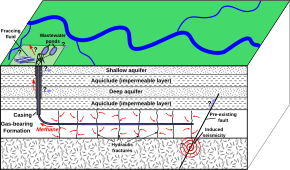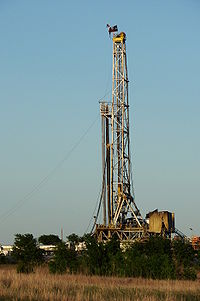 Schematic depiction of hydraulic fracturing for shale gas. | |
| Process type | Mechanical |
|---|---|
| Industrial sector(s) | Mining |
| Main technologies or sub-processes | Fluid pressure |
| Product(s) | Natural gas, petroleum |
| Inventor | Floyd Farris; J.B. Clark (Stanolind Oil and Gas Corporation) |
| Year of invention | 1947 |
| Fracking |
|---|
 |
| By country |
| Environmental impact |
| Regulation |
| Technology |
| Politics |
Fracking in Canada was first used in Alberta in 1953 to extract hydrocarbons from the giant Pembina oil field, the biggest conventional oil field in Alberta, which would have produced very little oil without fracturing. Since then, over 170,000 oil and gas wells have been fractured in Western Canada.[1][2]: 1298 Fracking is a process that stimulates natural gas or oil in wellbores to flow more easily by subjecting hydrocarbon reservoirs to pressure through the injection of fluids or gas at depth causing the rock to fracture or to widen existing cracks.[3]: 4
New hydrocarbon production areas have been opened as fracking stimulating techniques are coupled with more recent advances in horizontal drilling. Complex wells that are many hundreds or thousands of metres below ground are extended even further through drilling of horizontal or directional sections.[4] Massive fracturing has been widely used in Alberta since the late 1970s to recover gas from low-permeability sandstones such as the Spirit River Formation.[5]: 1044 The productivity of wells in the Cardium, Duvernay, and Viking formations in Alberta, Bakken formation in Saskatchewan, Montney and Horn River formations in British Columbia would not be possible without fracking technology. Fracking has revitalized legacy oilfields.[6] "Hydraulic fracturing of horizontal wells in unconventional shale, silt and tight sand reservoirs unlocks gas, oil and liquids production that until recently was not considered possible."[7] Conventional oil production in Canada was on a decrease since about 2004 but this changed with the increased production from these formations using fracking.[6] Fracking is one of the primary technologies employed to extract shale gas or tight gas from unconventional reservoirs.[3]
In 2012 Canada averaged 356 active drilling rigs, coming in second to the United States with 1,919 active drilling rigs. The United States represents just below 60 percent of worldwide activity.[8]: 21 New Brunswick, Newfoundland, Nova Scotia and Quebec have banned fracking.[9]
- ^ Stephen Ewing (25 November 2014). "Five facts on fracking". Calgary Herald. Retrieved 11 January 2015.
- ^ Milne, J.E.S.; Howie, R.D. (June 1966), "Developments in eastern Canada in 1965", Bulletin of the American Association of Petroleum Geologists, 50 (6)
- ^ a b "Understanding Hydraulic Fracturing" (PDF), Canadian Society for Unconventional Gas (CSUG), 2011, retrieved 9 January 2015
- ^ "The Facts About Fracking", Wall Street Journal, 25 June 2011, retrieved 9 January 2015
- ^ Cant, Douglas J.; Ethier, Valerie G. (August 1984), "Lithology-dependent diagenetic control of reservoir properties of conglomerates, Falher member, Elmworth Field, Alberta", Bulletin of the American Association of Petroleum Geologists, 68 (8)
- ^ a b Cite error: The named reference
Ewart_2014was invoked but never defined (see the help page). - ^ "Technologies and the Geology Perspective", Chinook Consulting Services, Calgary, Alberta, 2004, retrieved 9 January 2015
- ^ Maugeri, Leonardo (June 2013), The Shale Oil Boom: a U. S. Phenomenon (PDF), The Geopolitics of Energy Project, Belfer Center for Science and International Affairs, Harvard Kennedy School, retrieved 2 January 2014
- ^ "List of Bans Worldwide". Keeptapwatersafe.org. 14 September 2012.
